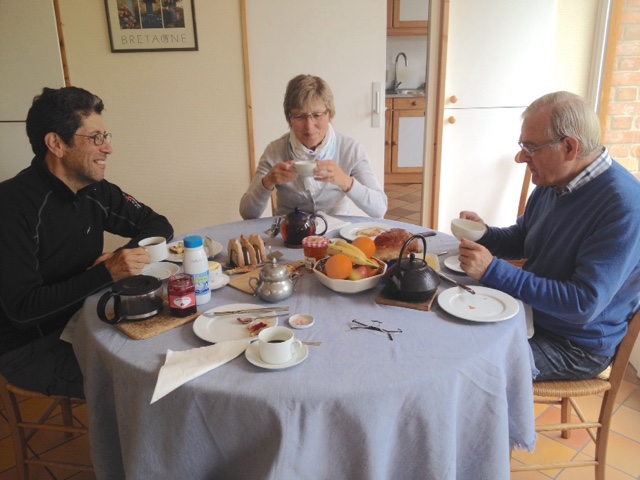I told Patrick that I was missing not having met other pilgrims, and how walking the Via Francigena on my own would have been difficult. The Camino Frances doesn't present that particular challenge. There are tons of other pilgrims there, though it is easy to be alone in one's thoughts whenever one wishes and sometimes to be alone in body as well. Patrick is good company and a good friend, but we both miss being part of a community of walkers as we were in Spain.
It wasn't just the just the chill and the low, slate-grey overcast, nor the aloneness. In the parts of France we had been walking through since Calais, there is a consistent narrative, towns and villages built and destroyed, rebuilt and destroyed again. The story there is written in conflicts with the English or Spaniards, with Flanders or Burgandy. To be sure, the two world wars also took a major toll. Even more recently, the destruction is economic and technological in origin. It is a region dotted by huge piles-become-hills and ridge-lines of coal mine tailings, now grown over with brush and trees to the point that they look like a part of the natural landscape.
From the time I left Arras, however, and especially as I walked from Bapaume to Perrone, the insanity of the Great War presented itself more acutely. You should be warned that my factual knowledge of WWI is limited. But this blog is about how I feel, and the few facts I have were engaged, that day, by that emptiness in the gut I got as I passed sign after sign —"South African Cemetery," "Australian Cemetery," "Manchester Cemetery." There are large national cemeteries in the area, but these burial grounds are smaller, at least the ones I saw are, memorials to a few dozen men, more personal, more heart churning than thousands upon thousands of white slabs or crosses. The small rectangularized arrows printed in neat sans serif, off white on green background, melded with the landscape in the same way those piles of tailings did, far too natural for my sensibilities.
Then I came to a sign, black on white, a German cemetery. The letters just felt harsher. That is not to say the German war dead do not deserve the same respect as the French and Commonwealth soldiers. Most, like their Ally counterparts, were not war makers, just more meat for the grinder. That sign, especially situated in front of the junked mechanical icon, that descendant on a different branch of the evolutionary tree from the Wotan A7V that saw action in 1918, a few dozen as armored fighting vehicles, several dozen more as troop carriers, was in no way natural.
On this part of the front, the region of the Somme, between 1914 and 1918, the German line advanced a mere 25 kilometers as measured by my thumbnail on a map I found a day or so later. How many bodies per kilometer, I wonder, in the taking and the losing.
My thoughts were lost in loss as I came upon two Aussies and a Brit walking the fields, tracing the movements in the Battle of Mount Saint Quentin, in the larger battle for Peronne. We chatted a bit. Not much about the war, but our conversation was quiet, respectful of where we were and what happened there. Not 100 meters after I left them, I came across a printed panel describing the action that took place there and the orders that had come down to take that strategic high ground overlooking Perronne, "regardless of loss."
I guess there are two ways to take that statement. A combat unit told that the only recourse for failure was death might not waver in the battle. They might understand the importance of their mission and vie more courageously for success. But that day, all I could think of was the other interpretation. What futility to know that if you were the last man standing you had better not stand for long despite the impossibility of odds. What hubris, to stand at the big chess board, moving men like game pieces, sacrificing pawns for a grander strategy. As it turns out, the Aussies won an important victory that day. As I understand it, they took the high ground and fought off German counterattacks. There were heroic actions by individuals, but there were also losses.
The chill did not leave me all day.
Comments welcome at garyontheway@gmail.com






























